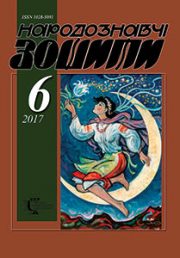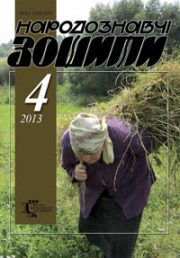The Ethnology Notebooks. 2021. # 2 (158), P. 314—326
УДК 930.2:398.341-035.3(477.83+477.85/.87=161.2)
DOI https://doi.org/10.15407/nz2021.02.314
Tetiana Hoshchitska
- ORCID ID: https://orcid.org/0000-0001-8596-8974
- Candidate of Historical Sciences,
- Doctor of Philosophy, researcher fellow of department
- of Historical Ethnology of the Institute of Ethnology
- The National Academy of Sciences of Ukraine,
- 15, Svobody Avenue, 79000, Lviv, Ukraine,
- e-mail: hoshchitska.tetiana@gmail.com
Introduction: Due to the significant involvement of wooden objects, along with various alloforms of ritual wood as important attributes in the traditional ritual culture of mountaineers, the important symbolic meaning, which in the traditional consciousness acquired some interior items made of wood. In the proposed exploration, the author aims to highlight the various beliefs and ideas associated with the objects of its internal filling made of wood.
Accordingly, the object of research is a complex of traditional rituals of the Ukrainians of the Carpathians, and the subject — household items made of wood, which often acquire symbolic functions, a certain sacred meaning and act as its attribute.
The main methods used by the author are structural-functional and comparative, other methods of ethnological science are also involved.
Scientific novelty: For the first time, various beliefs and ideas related to household items made of wood were comprehensively analyzed, and the specifics of their existence in the traditional ritual culture of Ukrainian mountaineers were analyzed. The place of the objects of internal filling of the dwelling, which were made of wood, was occupied in the traditional consciousness of Ukrainian mountaineers.
Results. It was found that Ukrainian mountaineers were accompanied in their daily lives by many wooden objects, which, in addition to purely utilitarian functions, were used as attributes in rituals, while acquiring a certain sacred status.
Conclusion: The fact that a chest, a cradle, a beautiful bowl and a shovel (involved primarily in family rituals, less often in calendar ceremonies) were of substantial semantic significance, was substantiated. Thus, the cradle in the area of the Ukrainian Carpathians, as everywhere in Slavonic, was symbolically perceived as the first human dwelling, and accordingly — carried an important semantic load. We see this in the example of many beliefs, even such rare ones as the idea of the need to select a «good» tree for it, and the fact that it must be made by a «knowledgeable» person. The chest also played a role in the rituals, and the attributes of baking were a beautiful bowl and a night.
Keywords: traditional rituals, Ukrainian Carpathians, beliefs related to housing, wooden furniture, cradle.
REFERENCES
- Franko, I. (1982). Ethnographic expedition to Boykivshchyna. InFranko, I. Works about 50 vol. (Vol. 36, pp. 68—99). Kyiv: Naukova dumka [in Ukrainian].
- Toporkov, A.L. (1990). Household utensils in the beliefs and rituals of Polesie. In: Ethnocultural traditions of the Russian rural population of the XIX—XX centuries (Issue 2, pp. 66—118) [in Russian].
- Davydiuk, V. (2009). «As There Was Nothing When the World Arose…» (On World-Creative Motives in Habituated Space of Polisian and Carpathian Ukrainians). The ethnology notebooks, 1—2, 110—114 [in Ukrainian].
- Hvozdevych, S. (1999). Something about the symbolism of cooperage products. Artaniia, 5, 44—45 [in Ukrainian].
- Tolstaia, S.M. (1995). Cradle. Slavic antiquities: Ethno linguistic dictionary (Vol. 2, рр. 559—562). Moscow: Mezhdunarodnyye otnosheniya [in Russian].
- Sokil, V., & Sokil, H. (1998). Folklore materials from the fatherland. Lviv [in Ukrainian].
- Franko, I. (1907). Galician-Russian folk sayings. In Etnohrafichnyj zbirnyk (Vol. 23, pp. 1—300) [in Ukrainian].
- Franko, I. (1910). Galician-Russian folk sayings. In Etnohrafichnyj zbirnyk (Vol. 28, pp. 1—541) [in Ukrainian].
- Goroshchko, L. (2005). Field materials before topic of «Сalendar and family custom and ceremonies» from the expedition to the Skolivs’kyj, Turkivs’kyj district, L’vivs’koi area, Verkhovyns’kyj district Ivano-Frankivs’koi area, Vyzhnyts’kyj, Putyl’s’kyj district, Chernivets’koi area, Rakhivs’kyj, Velykobereznians’kyj district, Zakarpats’koi area). In Archive of the IN NANU. F. 1. Оp. 2. Od. save 533. Arc. 1—183 [in Ukrainian].
- Gnatyuk, V. (2000). Description of Ukrainian mythology. Lviv: In-tut narodoznavstva NANU [in Ukrainian].
- Bojko, N. (2008). Field materials before topic of «MATERNITY RITE» from the expedition to the Bohorodchans’kyj district, Ivano-Frankivs’koi area, 11—24.07.2008). In Archive of the HF LNU. F. Od. save 244-E. Arc. 1—67 [in Ukrainian].
- Schnajder, J. (1910). People of Pechenizhyn. Lud (Vol. ХIII, pp. 21—33) [in Polish].
- Ganus, D.M. (2015). A child in the system of folk beliefs and rituals of the population of the Ukrainian-Polish border (Dissertation). Ivan Krypiakevych Institute of Ukrainian Studies of the National Academy of Sciences of Ukraine [in Ukrainian].
- Voitovich, N. (2015). Folk Demonology of Boykivshchyna. Lviv [in Ukrainian].
- Vincent, S. (2011). On a high mountain. Ivano-Frankivsk: Lileja-NV [in Ukrainian].
- Lintour, P. (Ed.). (1969). Dido-omniscient. Transcarpathian folk tales. Uzhhorod: Carpathians [in Ukrainian].
- Stankevych, M. (2002). Ukrainian artistic tree XVI—XX s. Lviv: In-tut narodoznavstva NANU [in Ukrainian]
- Kajndl’, R.F. (2000). Hutsuls: their lives, customs and folk traditions. Chernivtsi: Molodyj bukovynets’ [in Ukrainian].
- Levkievskaya, E.E. (2002). Slavic amulet. Semantics and structure. Моscow: Indrik [in Russian].
- Hlavats’ka, L., & Dubyna, R. (2010). Interior of the house of Eastern Boykivshchyna. Echoes of the ages, 1 (12), 22—25 [in Ukrainian].
- Falkowski, J. (1937). On the west border of Hutsylshchuna: on the wallej of Prut, Bystrzyca Nadwornianska, Bystrzyca Solotwinkia i Lomnica. Lviv [in Polish].
- Dovzheniuk, H. (2008) Children and song folklore. In: Folk culture of Ukrainians: human life cycle: historical and ethnographic research (Vol. 5, pp. 117—136) [in Ukrainian].
- Boyko, V.G. (Ed.). (1962). Ukrainian children’s folklore. Kyiv: Institute of Art History, Folklore and Ethnography [in Ukrainian].
- Derlytsia, M. (1898). Peasant children. Ethnographic essay, written by M. Derlytsia. Ethnographic collection (Issue 5, pp. 121—140) [in Ukrainian].
- Goisak, V. (2010). The linguistic picture of the world reflected in folk carols from Lemkivshchyna. Horlyts [in Ukrainian].
- Shukhevych, V. (1902). Hutsul’schyna. In: Materialy z ukrains’korus’koi etnolohii (Vol. VII, pp. 1— 300) [in Ukrainian].
- Yatsenko, M. (Ed.). (1971). Ukrainian folk songs recorded by Volodymyr Hnatyuk. Kyiv: Musical Ukraine [in Ukrainian].
- Markevych, N.A. (1991). Customs, beliefs, cuisine and drinks of Little Russians. In: Ukrainians: folk beliefs, beliefs, demonology (Pр. 52—169) [in Ukrainian].
- Radovych, R. (2020). Construction rituals of Boykos (based on materials from the eastern and middle parts of Boykivshchyna). The ethnology notebooks, 2, 330—349. DOI https://doi.org/10.15407/nz2020.02.330 [in Ukrainian].
- Nykorak, O. (2003). Traditional fabrics in the customs and rites of Ukrainians. Bulletin of Lviv University. The series is historical (Issue 38, pp. 543—567) [in Ukrainian].
- Mysevych, O. (1937). Ukrainian wedding ceremony in Boykivshchyna. Lviv [in Ukrainian].
- Horoshko-Pohorets’ka, L. (2019). «Tulysia mikh do mikha, a torba do torby» (pre-wedding customs at Pokuttia). The ethnology notebooks, 3, 346—353. DOI https://doi.org/10.15407/nz2019.03.580 [in Ukrainian].
- Stankevych, M. (2002). Ukrainian art tree of the XVI—XX centuries. Lviv: Institute of Ethnology of the National Academy of Sciences of Ukraine [in Ukrainian].
- Halaychuk, V. (2010). From the Spiritual Culture of Bohorodchany Region: Customs, Beliefs and Legends Related to the Conceptual Representation of Death and the Dead. Mythology and Folklore, 3—4 (7), 27—49 [in Ukrainian].
- Zynych, M. (1935). Funeral customs in the village of Zhukotin in the Turkish district. In Litopys Bojkivschyny: zapysky prysviacheni doslidam istorii, kul’tury i pobutu bojkivs’koho plemeni (Vol. V, part 6, pp. 14—18) [in Ukrainian].
- Mykhajlets’kyj, O. (1912). Funerals customs and ceremonies in the village Trostianytsy, Sniatyn district. Etnohrafichnyj zbirnyk (Vol. ХXXI—XXXII, pp. 302—315) [in Ukrainian].
- Kolberg, O. (1972). Rus Chervona (Part 1). In Works all (Vol. 54). Wroclaw; Poznan: Ludowa spoldzielnia wydawnicza [in Polish].
- Shekeryk-Donnykiv, P. (2009). The year in beliefs of Hutsuls. Verkhovyna [in Ukrainian].
- Krasykov, M. (2015). The death of death (before the understanding of Ukrainian national thanatology). In Folk culture of Ukrainian: life cycle of people (Vol. 5, pp. 173—206). Age. Death. Culture of worshiping the dead). Kyiv: Duliby [in Ukrainian].
- Kulish, P. (2015). The funeral written off from the words of the peasant, in the Kharkov province. In Folk culture of Ukrainian: life cycle of people (Vol. 5, pp. 401—405). Age. Death. Culture of worshiping the dead) Kyiv: Duliby [in Ukrainian].
- Dubyna, R. (2011). New Year’s cycle of holidays of the folk calendar of the Eastern Boykivshchyna. In: Sources to Ukrainian Ethnology: materials of field research (Pp. 131—137). Кyiv [in Ukrainian]
- Voropaj, O.(1993). The customs of our people. Ethnographic essay. Кyiv: Oberehy [in Ukrainian].
- Zdoroveha, N.I., & Utrysko, M. (1988). Folk customs and rites in Boykivshchyna. In Litopys Bojkivschyny, 2/48 (59), 48—54 [in Ukrainian].
- Huzij, R. (2007). Folk thanatology: Carpathological investigations. Lviv: In-tut narodoznavstva NANU [in Ukrainian].
- Kuziv, I. (1889). The life and customs of the mountain people. The Zoria: pys’mo lyteraturno-naukove dlia ruskykh’ rodyn’, 21, 351—352 [in Ukrainian].
- Vlad, M. (1992). Stritennie. Book of Hutsul customs and beliefs. Кyiv: Ukrains’kyj pys’mennyk [in Ukrainian].
- Finitsky, M. (Ed.). (1974). The mystery of the glass mountain. Transcarpathian folk tales are collected by Mykhailo Fintsytsky. Uzhhorod: Carpathians [in Ukrainian].
- Kmit, Yu. (1936). Dictionary of Boyko speech (Part V). Litopys Bojkivschyny: zapysky prysviacheni doslidam istorii, kul’tury i pobutu bojkivs’koho plemeni (Part 6, pp. 61—76) [in Ukrainian].
- Hvozdevych, S. (2012). Traditional cooperage of Ukrainians in the Carpathians (end of the XIX — 30s of the XX century). L’viv: Spolom [in Ukrainian].
- Zyubrovsky, A.V. (2015). Folk traditions of baking bread of Ukrainians of the south-western historical and ethnographic region in the late XIX — early XXI centuries. (Dissertation). Ivan Krypiakevych Institute of Ukrainian Studies of the National Academy of Sciences of Ukraine [in Ukrainian].
- Ziubrovs’kyi, A. (2010). Field materials before topic of «Bread in the traditional culture of Ukrainians» from the expedition to the Tyrkivskyj district, L’vivs’koi area, 27—29.08.2010. In Archive of the IN NANU. F. 1. Оp. 2. Od. save 684. Arc. 1—73 [in Ukrainian].
- Radovych, R. (2019). Interior of Pokuttia housing (second half of the XIX — beginning of the XX century). The ethnology notebooks, 3, 715—731. DOI https://doi.org/10.15407/nz2019.03.715 [in Ukrainian].
- Senchyk, Ya. (1912). Funeral customs and ceremonies in Kholmschyna and Pidlisia. Etnohrafichnyj zbirnyk (Vol. ХXXI—XXXII, pp. 384—387) [in Ukrainian].
- Kolessa, F. (1898). Popular beliefs in Pidhiria in the Khodovychi village, Stryi povit, recorded by Filaret Kolessa. Etnohrafichnyj zbirnyk (Vol. V, pp. 76—98) [in Ukrainian].
- Toporkov, A.L. (1995). Dej. Slavic antiquities: Ethno linguistic dictionary (Vol. 2, рр. 45—49). Moscow: Mezhdunarodnyye otnosheniya [in Russian].
- Ganus, D.M. (2015). A child in the system of folk beliefs and rituals of the population of the Ukrainian-Polish border. The thesis for the academic degree of Doctor of Historical Sciences with a specialization in Ethnology. Kyiv [in Ukrainian].
- Plotnykova, A.A. (1995). Оverstep. Slavic antiquities: Ethno linguistic dictionary (Vol. 4, рр. 13—16). Moscow: Mezhdunarodnyye otnosheniya [in Russian].
- Kmit, Yu. (1935). More about Volosatyj. In Litopys Bojkivschyny: zapysky prysviacheni doslidam istorii, kul’tury i pobutu bojkivs’koho plemeni (Vol V, part 6, pp. 1—8) [in Ukrainian].
- Shukhevych, V. (1999). Hutsul’schyna (Vol. 4). Verkhovyna [in Ukrainian].
- Miloradovich, V.P. (1991). Life and life of the Lubensk peasant. In: Ukrainians: folk beliefs, superstitions, demonology (Pр. 170—341). Kyiv: Lybid [in Russian].






